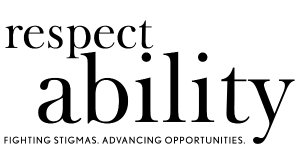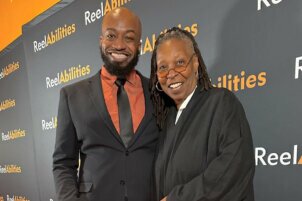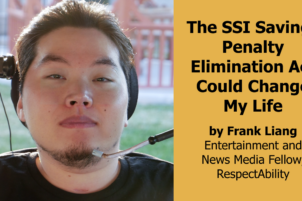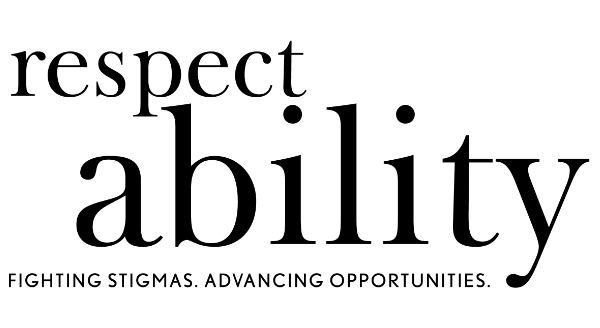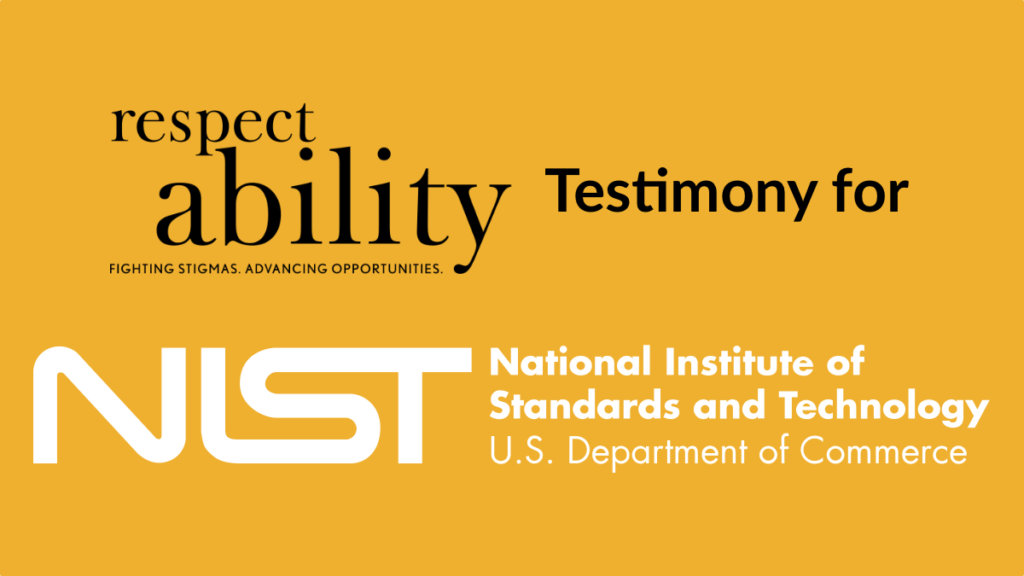 Washington, D.C., July 19 – Last week, RespectAbility submitted comments to the National Institute of Standards and Technology’s (NIST) Request for Information (RFI) regarding voting access for voters with disabilities.
Washington, D.C., July 19 – Last week, RespectAbility submitted comments to the National Institute of Standards and Technology’s (NIST) Request for Information (RFI) regarding voting access for voters with disabilities.
This RFI comes after President Biden signed an Executive Order on Promoting Access to Voting in March of this year. Within the Executive Order, President Biden called on the NIST, along with the Department of Justice, the Election Assistance Commission and other relevant agencies to “analyze barriers to private and independent voting for people with disabilities, including access to voter registration, voting technology, voting by mail, polling locations, and poll worker training.” This is a critical step towards understanding how to improve access for the 38 million eligible voters with disabilities in America who look to cast their ballots in future elections.
“Our survey work shows that 74 percent of likely voters are touched by disabilities,” said former Rep. Steve Bartlett, who was a primary author of the Americans with Disabilities Act of 1990 and currently serves as the Chairman of RespectAbility. “Candidates for office ignore the disability community at their peril.”
This Executive Order is one of the many ways in which the Biden-Harris Administration has worked to address voter access for Americans with Disabilities. Last week, Vice President Harris met with disability advocates from all over the nation to discuss voter accessibility as well as their lived experience casting their ballots in the 2020 election.
As the NIST reviews comments from organizations all over the country, RespectAbility’s team will continue to seek new opportunities to provide input and suggest best practices for future elections.
RespectAbility’s full testimony is presented online and below:
To: Leadership and Staff, National Institute of Standards and Technology (NIST)
From: Staff, Fellows and Board members, RespectAbility
Re: Public Comments on NIST-2021-0003-0001 Promoting Access to Voting
Dear Director Chambers and NIST Staff,
Thank you so much for the opportunity to offer our public comments on NIST-2021-0003-0001 Promoting Access to Voting. When talking about voting rights, it is easy to slip into high minded rhetoric instead of focusing on the critical infrastructure necessary to ensure that more Americans can be engaged, active citizens, invested in making their voices heard. For millions of American voters with disabilities, too often their voices are ignored, and they face distinct barriers to casting their ballots in local, state, and national elections. Likewise, given the great diversity and intersectionality of the disability community, issues impacting voters of color from marginalized communities directly harm many voters with disabilities and demand swift action from decision makers to protect their rights.
Before turning to answer the specific queries and questions offered in this Request for Information (RFI), it is critical to recognize the size, scope, and potential impact of voters with disabilities. The best available estimate of the number of eligible voters with disabilities was completed by hard working disability researchers at Rutgers University. The Rutgers University’s Program for Disability Research estimates that there are approximately 38 million eligible voters with disabilities. That is a major voting bloc and one that has the power to impact and swing elections for years to come. It is worth noting that the 2020 election proved that motivated voters with disabilities and voters from other marginalized communities could provide the decisive difference in closely contested elections. Electoral outcomes in Arizona, Georgia, Michigan, and Pennsylvania largely depended on candidates turning out minority voters despite barriers to voting and the looming threat of the pandemic.
After the election, Rutgers and the Election Assistance Commission (EAC) released a comprehensive study of the voting accessibility of the 2020 elections. Our submitted comments amplify their findings, and we echo them with our own polling research as well.
The Rutgers study highlighted the differences between the voting experience of individuals living with and without disabilities. Their report found that even in the unprecedented circumstances of the 2020 election, voters with disabilities were better accommodated than in the 2012 election. The study’s findings also shine a light on how much our nation still needs to grow to ensure that individuals living with disabilities can equitably cast their ballots.
While the COVID-19 pandemic forced more than 65 million Americans to cast their ballots by mail in 2020, this report highlighted that the voting accessibility of the 2020 election significantly improved since 2012. The shift to mail-in voting increased electoral participation for voters with disabilities. The disability community reported having 15 percent fewer incidences of voting difficulties in 2020 compared to 2012. This data is encouraging because 74 percent of all voters with disabilities voted by mail or early in-person during the 2020 election. Even though the majority of individuals with disabilities voted by mail in 2020, there was still a large group that voted in person. Indeed, RespectAbility’s own electoral outreach work, especially in Maryland and Georgia, found a marked preference among voters with disabilities and older voters for being able to physically cast their ballots. What this means for NIST and this RFI is that transportation access is an exogenous factor that directly impacts access to voting for potential millions of voters with disabilities. Luckily, individuals with disabilities who voted in person also reported having 12 percent fewer incidences of voting difficulties in 2020.
In addition to voters with disabilities having fewer voting difficulties, the accessibility of the 2020 election also improved in other noticeable ways. To begin with, fewer individuals with disabilities reported needing assistance to be able to cast their vote in 2020 compared to 2012. Specifically, only 6 percent of in-person voters needed assistance, and only 5 percent of mail-in voters needed assistance. These numbers dropped from 30 percent and 11 percent in 2012. Additionally, 82 percent of in-person voters with disabilities reported that their voting experience was very easy. This is significant because this perceived ease of voting has improved by 6 percent since 2012, and it was nearly identical to voters without disabilities in 2020. Finally, voters with disabilities also said that election officials were very respectful toward them, and most individuals reported they received sufficient accessible information on their possible voting options.
Even though voting accessibility has improved since 2012, there are still substantial differences in the equity of voting opportunity and access when comparing individuals with disabilities to their nondisabled peers. Specifically, voters with disabilities still encounter nearly twice as many voting difficulties as voters without disabilities, among both in-person and mail voters. Additionally, voters without disabilities were also able to vote independently without any difficulty at a much higher rate compared to voters with disabilities. It is also disappointing to note that 17 percent of voters with disabilities that needed assistance at the polls did not receive it. Finally, even though people with disabilities followed politics more and expressed more political interest than people without disabilities in 2020, people with disabilities still voted at a 7 percent lower rate than Americans without disabilities.
Voting difficulties occurred most frequently among people with vision and cognitive disabilities. These groups had the lowest voter turnout compared to all other disability types. Additionally, 30 percent of voters with cognitive disabilities reported having difficulty at polling places, and 22 percent of voters with low vision had problems with a mail ballot. Individuals with vision and cognitive impairments also had the lowest rates of being able to vote independently without difficulty.
While it is encouraging to see that voters with disabilities had fewer difficulties at the polls in 2020, these results must be taken with a grain of salt. When hearing these statistics, one might be quick to assume that these improvements might simply be the result of better polling place accessibility. However, the COVID-19 pandemic is likely responsible for the drop in voting difficulties because the pandemic forced most high-risk voters to vote by mail and individuals with less severe disabilities to vote in person in 2020. This composition change of voters at the polls is likely the reason why there were fewer reported difficulties among voters with disabilities. Since about 50 percent of individuals with disabilities would prefer to vote in person in the next election, work still needs to be done to improve voting accessibility for all individuals living with disabilities.
Additionally, even if voting accessibility at the polls is significantly improved, individuals with disabilities face many other roadblocks that hinder their political participation. Specifically, individuals with disabilities have lower employment rates, access to personal transportation, income, and education levels. These factors are all underlying reasons why the disability community votes at a lower rate than the rest of the population. Moving forward, elected officials, policymakers, and disability organizations need to find a way to address these issues and make systematic changes if our nation wants to see better voter turnout from the disability community.
Since more than 25 percent of adults in the United States have some type of disability, these findings need to be acted upon to ensure that voters with disabilities have more opportunities to accessibly exercise their right to vote.
The findings of the EAC/Rutgers University echoes many of the trends that RespectAbility saw in its own polling last year. COVID, the economy and access to healthcare motivated voters with disabilities to cast their ballots. Finding and motivating these voters will be a crucial strategy for future candidates for public office if they want to win. More details and in-depth data can be found on RespectAbility’s website here.
Beyond our comments above, RespectAbility’s team members also wished to respond directly and clearly to the specific questions contained in the NIST RFI. Those are succinctly included below:
1. Describe concerns regarding accessing the right to vote privately and independently for people with disabilities.
Concerns about privacy, voting, and independence depend very much upon the specific disabilities of the voter in question. To call back to the Rutgers study, 48 percent of people with disabilities have some form of mobility disability, 24 percent have cognitive issues, 18 percent have hearing issues, 12 percent have vision issues, 26 percent have difficulty leaving their homes unassisted, 13 percent have self-care disabilities and 32 percent need support in completing activities of daily living. For those with vision issues, having an accessible copy of the ballot is of critical importance, yet PDFs are often posted online without alt-text or having been checked for accessibility. Blind voters may need Braille documentation or sighted assistance in order to cast their votes. For example, 22 percent of blind voters reported difficulty in completing their mail ballots in 2020. For people with intellectual or developmental disabilities, plain language summaries of ballot issues and ballots themselves are critically important. Voters who are deaf or hard of hearing may have not had challenges physically going in to cast their vote on election day but unless that voting site has an ASL interpreter, a volunteer prepared to handle accessibility issues, or the person with a disability has an alternate means of communication, they may encounter challenges.
2. Describe effective strategies, techniques, and technologies for addressing the barriers faced by voters with disabilities throughout the voting process.
The disability community lives by the motto “Nothing about us, without us”.We must have a seat at any decision-making table that affects us (which is every table, as disability cuts across all other demographics), because those with lived experience know solutions that work and must be part of any effective solution. As such, the more opportunities for people with disabilities themselves to become more active citizens and become civically engaged is critically important. State based coalitions of voters with disabilities have helped educate candidates and push for more resources to support voting accessibility.
3. Describe barriers that people with disabilities encounter in getting useful information about the voting process.
Candidates for public office and their campaigns themselves create a significant barrier to the participation of voters with disabilities by the lack of accessible campaign materials, hosting events in physically inaccessible locations, and by not having disability issues are part of the policy platforms. RespectAbility as well as other disability advocacy and independent living organizations have done our best to develop simple materials to educate candidates and campaign staff on the essential principles of accessibility. These include directed outreach to leaders with disabilities, event accessibility/accommodations, hiring staff with disabilities, disability inclusion in written materials, using respectful language, ensuring media accessibility, ensuring captioning on all video materials, and meaningfully recognizing the racial/ethnic intersectionality of the disability community. Likewise, it is the incumbent responsibility of campaigns to train their staff and volunteers on how to provide information to the disability community in a variety of formats as well as accurate information on the voting process. Key topics that need to be covered include but are not limited to person-first language, accessible event management, and disability etiquette. All topics that many disability organizations have developed resources to address.
4. Describe barriers that people with disabilities encounter with ballots, and in getting useful information about the items on the ballot.
The issue and importance of plain language summaries, materials, and documentation cannot be understated. This is especially important for the approximately 4 million Americans with intellectual and/or development disabilities and their families. Even parents of students with disabilities benefit from having clear, simple information about how ballot initiatives that impact school and special education will help or harm their children. While the Plain Writing Act has been law since 2010 and the U.S. Election Assistance Commission has stated commitments around plain language documentation, more public-facing and transparent work is needed to address these challenges.
5. Provide recommendations for improving voter access for people with disabilities.
Referring once again back to the Rutgers University study quoted extensively above, if you drill down deep into the data, there are two clear steps that are necessary to improve voter access for people with disabilities: better polling places and consistent voting procedures. While voting accessibility has slowly improved from 2012 to 2016 to 2020, many polling places are still located in inaccessible venues. As recently as 2017, a Government Accountability Office (GAO) study found that 60 percent of polling places they inspected had one or more potential inaccessible barriers. As such, local authorities should do what they can to communicate directly to voters with disabilities about the accessibility of their local polling. Some local boards of elections indicated online whether your polling place is ADA accessible or not and that time of information needs to be more widely spread. Likewise, supporting states to ensure greater consistency in voting procedures is also critical. Lastly, the experiences of the 2020 election proved several critical lessons that are now guiding the actions of disability and civil rights advocacy organizations. The widespread use of mail-in ballots was certainly a win from the accessibility perspective, but the reactionary turn towards signature matching and identification requirements will do long term harm to voters with disabilities.
6. Identify what has had the most impact enabling people with disabilities to vote privately and independently.
It is critical to recognize the ease, flexibility, and opportunities created by increased options for absentee ballots and mail-in voting. As noted previously, 74 percent of all voters with disabilities voted by mail or early in-person during the 2020 election. Even before the pandemic, disability rights advocates had been pushing states to embrace greater flexibility and more options for early voting. The long-term impact of that work was evident in the turnout seen among voters with disabilities and their families. Even if our nation gets through the 2022 or 2024 election cycles without having to face another plague or pestilence, accessibility options gained because of COVID-19 should not be lost. Instead of turning away from flexible voting options, more states and localities should embrace them. For example, the great states of Vermont, Colorado, Utah, Nevada, Oregon, Washington, and Hawaii have all had great success with automatic mail-in ballot initiatives, as has the District of Columbia. Critically, despite false faced partisan commentary to the contrary, there is no statistical evidence to suggest that vote-by-mail favors one party over another. As such, our nation and our democracy has much to gain by expanded voting options.
7. Identify gaps that remain in making voting accessible to people with disabilities.
Beyond the previously identified gaps faced by millions of voters with disabilities, transportation is another exogenous factor that directly impacts voting access within the disability community. As noted previously in our comments, in Maryland and Georgia, our team found a marked preference among voters with disabilities and older voters for being able to physically cast their ballots. As such, we supported local organizations that prioritized collaborative opportunities to arrange transportation for voters with disabilities and older Americans. Likewise, if you cannot physically bring the voter with a disability to the polling place, bring the ballot to them. Ensuring that people with disabilities living in group settings or older Americans in assisted living facilities have opportunities to submit mail-in or absentee ballots is critical. That in turn will require local election authorities to have clear procedures and trained staff/volunteers. Challenges certainly remain, but they are challenges that can be overcome with purposeful action.
8. Describe barriers that people with disabilities encounter with completing online forms for the voting process.
People who are blind or have other visual impairments are not the only people who can benefit from having more accessible online forms. As noted in 2019 by the UX Collective, people with cognitive disabilities, people who use speech-to-text software, and those with limited physical dexterity also benefit from more accessible online forms. The steps to make a form more accessible are universal, whether we are talking about a local board of election website or some other web platform. Forms need to be keyboard accessible, contrasting colors need to be used, form fields need clear labels, and reminder text is important. Given both the business value of greater accessibility and the range of resources to support greater online accessibility, there is no excuse for online forms related to the voting process to be inaccessible. Technical assistance from the EAC or collaboration between subject matter experts and local voting authorities may be necessary, but the solutions are out there for the taking.
9. Describe barriers that people with disabilities encounter in getting useful information about their eligibility to vote.
Many of the same challenge noted above around campaign communication, online forms, and the need for accessibility also obtain when considering seeking information about voter eligibility. There is a profound role to be played by community provider organizations and independent living groups who do some of the most important, direct work with millions of potential voters with disabilities. As such, greater civic engagement and expanded resources are needed and there is a nature point of partnership between local election authorities and such organizations.
10. Describe barriers that people with disabilities encounter with registering to vote.
Our public comments have previously noted the critical important of the diversity and intersectionality of the disability community. Our community is unique in that anyone, at any time, can join the nation’s largest minority. Issues impacting voters of color from marginalized communities directly harm many voters with disabilities. As such, it is worth noting that accessing proper identifying documentation is a challenge for people of color, people of color with disabilities, and those in the wider disability community. People in each of those categories drive less than other communities, are often poor and live in urban areas, creating less need for driver’s licenses, one of the most common forms of government ID. Likewise, systemic racism creates additional barriers to ensuring fair, free, and open access to voting. In recent years, automatic voter registration initiatives have spread widely in states, creating opportunities to connect people from across different communities to information about voting. Given the adamant insistence on voter identification requirements in many states from many different political factions, encouraging automatic voter registration is a natural pathway for connecting more people with and without disabilities with the tools, the means, and the information necessary to become active, engaged citizens. Lastly, the value of community and coalition drive events such as National Voter Registration Day cannot be overstated, and RespectAbility is proud to have been an annual event partner since 2015. More details here: https://nationalvoterregistrationday.org/ And here: https://therespectabilityreport.org/?s=National+Voter+Registration+Day
11. Describe barriers that people with disabilities encounter using technology for the registration or voting process, whether online, in person, or via mail.
Previous commentary in several section of our comments addresses this point in sufficient detail.
12. Describe the availability of accessible voting equipment.
RespectAbility’s team has communicated with local disability organizations in many different states, and we have consistently found that the availability voting equipment is in fact wildly inconsistent and widely divergency based on geography and local leadership. As such, NIST should consider engaging more disability advocacy organizations for their perspectives on promoting commonality in accessible voting equipment, work to ensure common standards across localities and ensure the full scope of HAVA resources are being wisely invested in proven solutions. More details and background here: https://nfb.org/programs-services/center-excellence-nonvisual-access/national-center-nonvisual-election-4, here: https://www.ncsl.org/research/elections-and-campaigns/voting-equipment.aspx, and here: https://www.afb.org/aw/3/6/14889
13. Describe barriers that people with disabilities encounter with voting by mail.
Previous commentary in several section of our submission addresses this point in sufficient and greater detail.
14. Describe security considerations relevant to existing and potential technologies used by people with disabilities in the voting process.
Election security is a topic beyond the scope of the competencies, knowledge, and professional experiences of RespectAbility’s staff and fellows. As such, we defer to the recommendations of other authorities and advocacy organizations dedicated to this critical topic. We will say, however, respond in three ways. First, it must be said that this is the third decade of the twenty-first century and the world’s greatest nation lags far behind other, smaller nations that successfully and securely embrace online voting in local, regional, and nation elections. From a purely nationalistic perspective, it is frankly embarrassing that the United States of America is not at the cutting edge of technological platforms for digital citizenship and technologically connected civic engagement. Second, the 2020 election raised the eternally recurring debate over security and accessibility of elections, yet such false dichotomies also distract from the inherent good of greater accessibility. Third, never underestimate the universal value and return on investment from expanded accessibility and more advanced forms of accommodations. Workers with disabilities requested telework/remote work options and software for decades, only for the pandemic to make remote work a preferred means of professional work. As such, better, more inclusive technology will ultimately prove to be better, more secure, and more sophisticated technology.
15. Describe barriers that people with disabilities face at polling locations.
Please see our above comments referencing GAO-18-4 Voters with Disabilities: Observations on Polling Place Accessibility and Related Federal Guidance. To quote: “Of the 178 polling places, GAO was able to fully examine voting stations inside the voting area at 137. Of these 137 polling places, 65 percent (89) had a voting station with an accessible voting system that could impede the casting of a private and independent vote.” Critically, this GAO report also included specific recommended courses of action to be followed by the Department of Justice. At this time, DOJ is continuing to look at ways to follow GAO’s recommendations and continued actions internal to the federal government is needed. Read more here: https://www.gao.gov/products/gao-18-4
16. Describe the accessibility of polling places.
Please see our comment above and the GAO report on this topic.
17. Identify areas where poll worker training can address barriers experienced by people with disabilities.
There are two specific ways in which poll worker training can be optimized and prioritized to address the barriers faced by voters with disabilities and promote a more universally inclusive voting experience. First and foremost, poll worker training should include specific modules about diversity, equity, accessibility, and disability issues. Such materials do not need to be exhaustive given the limited hours available for poll worker training. However, workers do need to be given more resources so they can understand the wider voting public that they will be serving on election day. RespectAbility and other engaged, inclusion organizations have extensive, free resources that can be adapted, distilled, or otherwise used for such training. Second, from our organizational experience, having clear checklists and common procedures can help poll workers address key barriers experienced by people with disabilities at the polls. Each polling place could have a standard accessibility checklist and assigned person responsible for addressing any accessibility questions. Having a specific “playbook” for how to support a person based on their type of disability could be useful. At the same time, the inclusive principle of “ask the person” is also important. People with disabilities themselves are the best judges of what they need and how they should be accommodated. As such, never estimate the importance of disability etiquette and respect in preparing poll workers for the challenges they will face.
18. Identify areas where clearer or better policies can address barriers experienced by people with disabilities.
In deference to the already extensive length of these comments, the RespectAbility teams invites any and all interested parties to learn more about our organizational agenda and our specific policy priorities to address these critical barriers on our website at https://www.respectability.org/resources/Policy-Makers/
19. Describe any barriers that people with disabilities face to voting that disproportionately impact communities of color, persons who live in rural areas; and persons otherwise adversely affected by persistent poverty or inequality.
As a starting point for many decisionmakers, it is critical to recognize the true scope of issues and needs among the most marginalized communities in American society. There are 12.8 million Black, Indigenous and People of Color (BIPOC) with disabilities who have long been harmed by structural racism and who are disproportionately impacted by the COVID-19 pandemic and resulting economic crisis. Our society is at its best when all people, including Black, Indigenous and People of Color (BIPOC) people with disabilities, can earn an income and become independent, just like anyone else. We must all fight racism and prejudice of all kinds. That work must go well beyond words and move into real systems change so we can create true equity and opportunities. The pandemic has made clear that the nation must transform itself to advance racial justice and make equitable opportunities a reality. Achieving that reality must begin by making voting itself a fairer, more equitable and accessible process. As such, we look forward to working with you on this process.
20. Of the concerns and barriers noted, identify the most serious and impactful barriers faced by voters with disabilities throughout the voting process.
As a parting comment, it is critical to recognize that culture proceeds politics. One of the major causes of lower voter turnout and lower levels of civic engagement among people with disabilities is stigma. People with disabilities have been seen for decades as “less than” – as incapable of doing jobs, as unworthy of being voters, or as undesirable members of communities. Stigma dampens disability employment in every employment sector, harms the engagement of voters with disabilities and isolates people with disabilities from their communities. As such, we need elected officials who will use their public platforms to help fight stigmas by demonstrating a commitment to community inclusion, celebrating the contributions of people with disabilities, and marking key celebrations such as National Disability Employment Awareness Month. More important than even having proven legislative allies of the disability community, we need more people with disabilities to run for local, state and national political offices. The disability community lives by the motto “Nothing about us, without us” that we must have a seat at any decision-making table that affects us (which is every table, as disability cuts across all other demographics), because those with lived experience know solutions that work and must be part of any effective solution. As such, our nation will begin to fulfil its grand promise by choosing more and more leaders who reflect the truly staggering and beautiful diversity of the American people themselves.
These comments were prepared thanks to the hard work and close attention of RespectAbility’s Fellows, Staff, and Board Members. Special credit is due to past and current Fellows Nakia Sims, Morgan Davis, Claudia Runk, Gabriella Marquez, Taylor Ragano, Taylor Easley, Ian Malesiewski, Stephanie Santo, Zoltan Boka, Chinyere Azike, and Adam Fishbein who have been active contributors to our organization’s work on policy advocacy, civic engagement and advancing disability inclusion. They represent future leaders who will have a substantial impact on the opportunities and aspirations of millions of Americans with disabilities.
